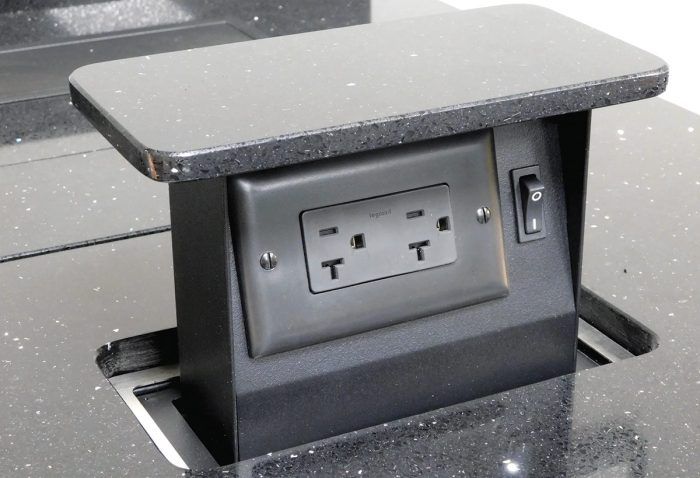Receptacles for a Kitchen Island
With a ban on below-counter receptacles in the latest National Electrical Code, there are a few other ways to incorporate receptacle outlets on a peninsula or island.

I’m in the process of planning for a kitchen remodel and see conflicting information online regarding the electrical codes governing outlets on islands. Is it true that I can no longer install outlets on the sides of the island’s base cabinets?
—Jason Bouchard, Hudson, Wis.
Electrical consultant John Williamson replies: It is true: Receptacle outlets are no longer permitted to be installed on the side of island and peninsula base cabinets below the countertop. Over the years, one priority of the National Electrical Code (NEC) has been to require an adequate number and convenient locations of receptacles in a home so that homeowners are not tempted to use extension cords, which can cause tripping-related accidents and are susceptible to water spills and damage by foot traffic. For several decades, reducing the need for extension cords was the motivation that led to the mandate for receptacle outlets to be located on islands and peninsulas.
The NEC is updated every three years, and during the revision cycle for the 2023 NEC the Consumer Product Safety Commission (CPSC) provided 20 years of data that highlighted thousands of injuries caused by countertop cooking appliances. Their investigations found that people (many of them children) had inadvertently snagged appliance cords draped over the edge of countertops, which caused the spillage of hot foods and beverages. This is why receptacles below the counter are no longer code compliant for new installations under the 2023 NEC provisions.
In addition to the ban on below-counter receptacles, the 2023 NEC no longer mandates that any receptacles be installed on islands and peninsulas. So, your first option is to skip the receptacles altogether. If you go this route, keep in mind that wiring provisions still need to be provided at the island or peninsula for the future installation of receptacles. The best option is to run one of the 20-amp kitchen circuits to the interior of the island or peninsula base cabinets to power future receptacles. Simply dead-end the #12 AWG copper type NM-B cable in a junction box with a blank cover plate labeled “Power for future receptacles.” Make sure to twist on wire caps to both the black and white wires before you tuck the cable into the box and install the cover plate.
If you decide to install receptacle outlets on your island or peninsula, don’t forget that receptacles are never permitted to be installed face up in a countertop unless they are part of a factory-made, certified “receptacle outlet assembly” approved for kitchen countertop use by an OSHA-recognized product-testing organization. These receptacles are specifically protected from the intrusion of liquids and foreign objects.
Be aware that many of those pop-up/pop-out receptacles you see on an office desk, conference-room table, or other similar work surface are not designed to prevent the intrusion of large amounts of spilled liquids that could be present on a countertop used for food preparation. If you use a pop-up receptacle, it must be approved for countertop use.
In addition to the pop-up option, island and peninsula receptacles are permitted to be installed above the countertop. Receptacles could be installed in the backsplash on a multilevel countertop that has a snack bar, or on the underside of the overhead cabinets or suspended shelving. Whichever you choose, the receptacle needs to be installed not more than 20 in. above the surface of the countertop.
In general, the NEC does not apply retroactively, and these new changes are only applicable to all new installations as part of new construction or renovations. In other words, the millions of homeowners that do have existing below-counter outlets are not required to remove them until their next big kitchen remodel. That said, if they believe their below-counter receptacles are a safety hazard for the small children in their homes, they can certainly remove the existing receptacles and just install blank cover plates.
RELATED STORIES
Fine Homebuilding Recommended Products
Fine Homebuilding receives a commission for items purchased through links on this site, including Amazon Associates and other affiliate advertising programs.

8067 All-Weather Flashing Tape

Affordable IR Camera

Reliable Crimp Connectors





















